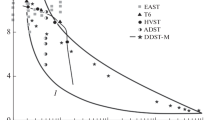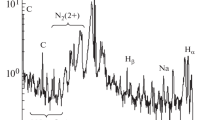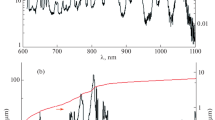The paper presents the results of studies with the use of shock tubes at the Institute of Mechanics of the M. V. Lomonosov Moscow State University, in which measurements were made of the radiation of shock-heated gases simulating the conditions of the entry of spacecraft into the atmosphere of the Earth and other planets of the Solar system with orbital and superorbital velocities. A description of the measuring equipment is given, as well as techniques of diagnostics and processing of the obtained spectroscopic information. Numerous experimental data on the radiation of shock-heated gases in a wide range of the radiation spectrum from vacuum ultraviolet to infrared have been analyzed, which serve as the basis for the development of various gas-dynamical models.
Similar content being viewed by others
References
A. M. Brandis, C. O. Johnson, and B. A. Cruden, Investigation of non-equilibrium radiation for Earth entry, AIAA Paper, No. 2016–3690 (2016).
S. T. Surzhikov, Calculation of nonequilibrium radiation of shock waves in air using two models, Izv. Ross. Akad. Nauk, Mekh. Zhidk. Gaza, No. 1, 99–114 (2019).
J. S. Shang and S. T. Surzhikov, Nonequilibrium radiative hypersonic flow simulation, Prog. Aerospace Sci., 53, 46–65 (2012).
K. N. Volkov, V. N. Emel′yanov, A. G. Karpenko, and S. S. Tolstoguzov, Mathematical simulation of the supersonic gas flow over a wedge with an attached shock wave and high-temperature effects, J. Eng. Phys. Thermophys., 95, No. 3, 742–751 (2022).
M. Lino da Silva, R. Rerreira, J. Vargas, R. Rodrigues, B. Carvalho, L. L. Alves, B. Gonçalves, A. Smith, J. Merrifield, S. McDowell, D. Evans, P. Reynier, V. F. Villace, and L. Marraffa, European shock-tube for high enthalpy research: Design and instrumentation, manufacturing, and acceptance testing, AIAA Paper, No. 2020–0624 (2020).
B. A. Cruden and A. M. Brandis, Measurement and prediction of radiative non-equilibrium for air shocks between 7–9 km/s, AIAA Paper, No. 2017–4535 (2017).
L. Campoli, O. Kunova, E. Kustova, and M. Melnik, Models validation and code profiling in state-to-state simulations of shock heated air flows, Acta Astronaut., 175, 493–509 (2020).
A. M. Brandis, B. A. Cruden, D. Prabhu, D. Bose, M. McGilvray, and R. G. Morgan, Analysis of air radiation measurements obtained in the EAST and X2 shock tube facilities, AIAA Paper, No. 2010–4510 (2010).
M. McGilvray, L. J. Doherty, R. G. Morgan, and D. E. Gildfind, T6: The Oxford University stalker tunnel, AIAA Paper, No. 2015–3545 (2015).
R. Parker, A. Dufrene, M. Holden, and T. Wakeman, Shock-front emission measurements at 10 km/s, AIAA Paper, No. 2011–715 (2011).
O. Igra and F. Seiler (Eds.), Experimental Methods of Shock Wave Research, Springer, New York (2016).
P. Reyner, Survey of high-enthalpy shock facilities in the perspective of radiation and chemical kinetics investigations, Prog. Aerospace Sci., 85, 1–32 (2016).
S. Gu and H. Olivier, Capabilities and limitations of existing hypersonic facilities, Prog. Aerospace Sci., 113, Article ID 100607 (2020).
G. Ya. Gerasimov, P. V. Kozlov, I. E. Zabelinskii, N. G. Bykova, and V. Yu. Levashov, Investigation of radiation characteristics of high-temperature gases in shock tubes, Khim. Fiz., 41, No. 8, 1–14 (2022).
Yu. V. Akimov, N. G. Bykova, I. E. Zabelinskii, P. V. Kozlov, and V. Yu. Levashov, Experimental complex "Shock tube"; https://istina.msu.ru/equipment/card/279166300/.
N. G. Bykova, I. G. Gerasimov, I. E. Zabelinskii, L. B. Ibragimova, and O. P. Shatalov, Investigation of shock-heated air in the spectral range 120–900 nm: A panoramic spectrum and radiation evolution behind the shock wave front, Fiz.-Khim. Kinet. Gaz. Dinam., 15, No. 2, 1–7 (2014).
I. E. Zabelinskii, P. V. Kozlov, Yu. V. Akimov, N. G. Bykova, G. Ya. Gerasimov, Yu. V. Tunik, and V. Yu. Levashov, Detonation initiation of strong shock waves for studying radiation characteristics of high-temperature gases, Khim. Fiz., 40, No. 11, 22–28 (2021).
V. A. Pavlov and G. Ya. Gerasimov, Measurement of ignition limits and induction times of hydrogen–air mixtures behind the incident shock wave front at low temperatures, J. Eng. Phys. Thermophys., 87, No. 6, 1291–1297 (2014).
V. A. Pavlov and G. Ya. Gerasimov, Ignition of hydrogen–oxygen mixtures behind the incident shock wave front, J. Eng. Phys. Thermophys., 89, No. 3, 587–591 (2016).
P. V. Kozlov, I. E. Zabelinsky, N. G. Bykova, G. Ya. Gerasimov, V. Yu. Levashov, and V. Yu. Tunik, Experimental study of air radiation behind a strong shock wave, Acta Astronaut., 194, 461–467 (2022). 21. P. V. Kozlov and S. T. Surzhikov, Nonequilibrium radiation NO in shocked air, AIAA Paper, No. 2017–0157 (2017).
22. G. N. Zalogin, P. V. Kozlov, L. A. Kuznetsova, S. A. Losev, V. N. Makarov, Yu. V. Romanenko, and S. T. Surzhikov, Radiation of the CO2–N2–Ar mixture in shock waves: Experiment and theory, Zh. Tekh. Fiz., 71, No. 6, 10–16 (2001).
23. P. V. Kozlov, I. E. Zabelinsky, N. G. Bykova, Yu. V. Akimov, V. Yu. Levashov, G. Ya. Gerasimov, and A. M. Tereza, Development of a technique for recording the gas radiation intensity behind the front of strong shock waves, Khim. Fiz., 40, No. 8, 26–33 (2021).
24. N. G. Bykova, I. E. Zabelinsky, L. B. Ibragimova, P. V. Kozlov, S. V. Stovbun, A. M. Tereza, and O. P. Shatalov, Radiation characteristics of air in the ultraviolet and vacuum ultraviolet regions of the spectrum behind the front of strong shock waves, Khim. Fiz., 37, No. 2, 35–41 (2018).
25. A. M. Brandis, C. O. Johnston, B. A. Cruden, D. Prabhu, and D. Bose, Uncertainty analysis and validation of radiation measurements for earth reentry, J. Thermophys. Heat Transf., 29, No. 2, 209–221 (2015).
P. V. Kozlov, I. E. Zabelinsky, N. G. Bykova, G. Ya. Gerasimov, N. Yu. Levashov, and A. M. Tereza, Experimental study of radiation from shock-heated air in spectral range 120–900 nm, Proc. 28th Int. Colloq. Dynam. Explos. React. Syst., 19–24 June, 2022, Napoli (2022), pp. 86–90.
27. P. V. Kozlov, Experimental study of the radiation properties of air behind the shock wave front at velocities of up to 10 km/s, Fiz.-Khim. Kinet. Gaz. Dinam., 17, No. 1, 1–13 (2016).
P. L. Collen, L. J. Doherty, and M. McGilvray, Measurements of radiating hypervelocity air shock layers in the T6 free-piston driven shock tube, Proc. Int. Conf. on Flight Vehicles, Aerothermodynamics and Re-Entry Missions and Engineering (FAR 2019), 30 September–03 October 2019, Monopoli, Italy (2019), No. 1053360.
https://data.nasa.gov/docs/datasets/aerothermodynamics/EAST/index.html.
P. V. Kozlov, I. E. Zabelinsky, N. G. Bykova, G. Ya. Gerasimov, and V. Yu. Levashov, Experimental study of the emissive characteristics of shock-heated air in the ultraviolet and visible region of the spectrum, Izv. Ross. Akad. Nauk, Mekh. Zhidk. Gaza, 57, No. 6, 85–93 (2022).
B. Cruden, R. Martinez, J. Grinstead, and J. Olejniczak, Simultaneous vacuum ultraviolet through near IR absolute radiation measurement with spatiotemporal resolution in an electric arc shock tube, AIAA Paper, No. 2009–4240 (2009).
A. M. Brandis and B. A. Cruden, Benchmark shock tube experiments of radiative heating relevant to earth re-entry, AIAA Paper, No. 2017–1145 (2017).
33. R. J. E. Abrantes, A. R. Karagozian, D. Bilyeu, and H. P. Le, Complexity reduction eff ects on transient, atomic plasmas, J. Quant. Spectrosc. Radiat. Transf., 216, No. 1, 47–53 (2018).
34. K.-B. Chai and D.-H. Kwon, Optical emission spectroscopy and collisional-radiative modeling for low temperature Ar plasmas, J. Quant. Spectrosc. Radiat. Transf., 227, No 1, 136–144 (2019).
M. G. Kapper and J.-L. Cambier, Ionizing shocks in argon. Part I: Collisional-radiative model and steady state structure, J. Appl. Phys., 109, Article ID 113308, (2011).
36. V. Yu. Levashov, P. V. Kozlov, N. G. Bykova, and I. E. Zabelinskii, Specifi c features of argon plasma radiation at the initial statge behind the shock wave front, Khim. Fiz., 40, No. 1, 16–23 (2021).
N. G. Bykova, I. E. Zabelinskii, L. B. Ibragimova, P. V. Kozlov, V. Yu. Levashov, and O. P. Shatalov, Excitation and emission of argon behind the front of shock waves at velocities 4.5–7.8 km/s. 1. Experimental investigation, Fiz.-Khim. Kinet. Gaz. Dinam., 18, No. 1, 1–12 (2017).
38. P. V. Kozlov, I. E. Zabelinskii, N. G. Bykova, V. Yu. Levashov, and G. Ya. Gerasimov, Experimental investigation of argon radiation behind the front of a strong shock wave, Zh. Prikl. Spektrosk., 88, No. 2, 244–248 (2021).
A. S. Dikalyuk, S. T. Surzhikov, O. P. Shatalov, P. V. Kozlov, and Y. V. Romanenko, Nonequilibrium radiation behind the strong shock waves in Martian and Titan atmospheres: Numerical rebuilding of experimental data, AIAA Paper, No. 2012–0795 (2012).
A. S. Dikalyuk, S. T. Surzhikov, P. V. Kozlov, O. P. Shatalov, and Y. V. Romanenko, Nonequilibrium spectral radiation behind the shock waves in Martian and Earth atmospheres, AIAA Paper, No. 2013–2505 (2013).
41. P. V. Kozlov, I. E. Zabelinskii, N. G. Bykova, G. Ya. Gerasimov, and V. Yu. Levashov, Experimental investigation of radiative characteristics of a CO2–N2 mixture behind the front of a strong shock wave, Khim. Fiz., 40, No. 12, 23–28 (2021).
Author information
Authors and Affiliations
Corresponding author
Additional information
Translated from Inzhenerno-Fizicheskii Zhurnal, Vol. 96, No. 7, pp. 1861–1872, November–December, 2023.
Rights and permissions
Springer Nature or its licensor (e.g. a society or other partner) holds exclusive rights to this article under a publishing agreement with the author(s) or other rightsholder(s); author self-archiving of the accepted manuscript version of this article is solely governed by the terms of such publishing agreement and applicable law.
About this article
Cite this article
Kozlov, P.V., Levashov, V.Y., Gerasimov, G.Y. et al. Study of Radiation Characteristics of Shock-Heated Gases. J Eng Phys Thermophy 96, 1828–1838 (2023). https://doi.org/10.1007/s10891-023-02852-4
Received:
Published:
Issue Date:
DOI: https://doi.org/10.1007/s10891-023-02852-4




